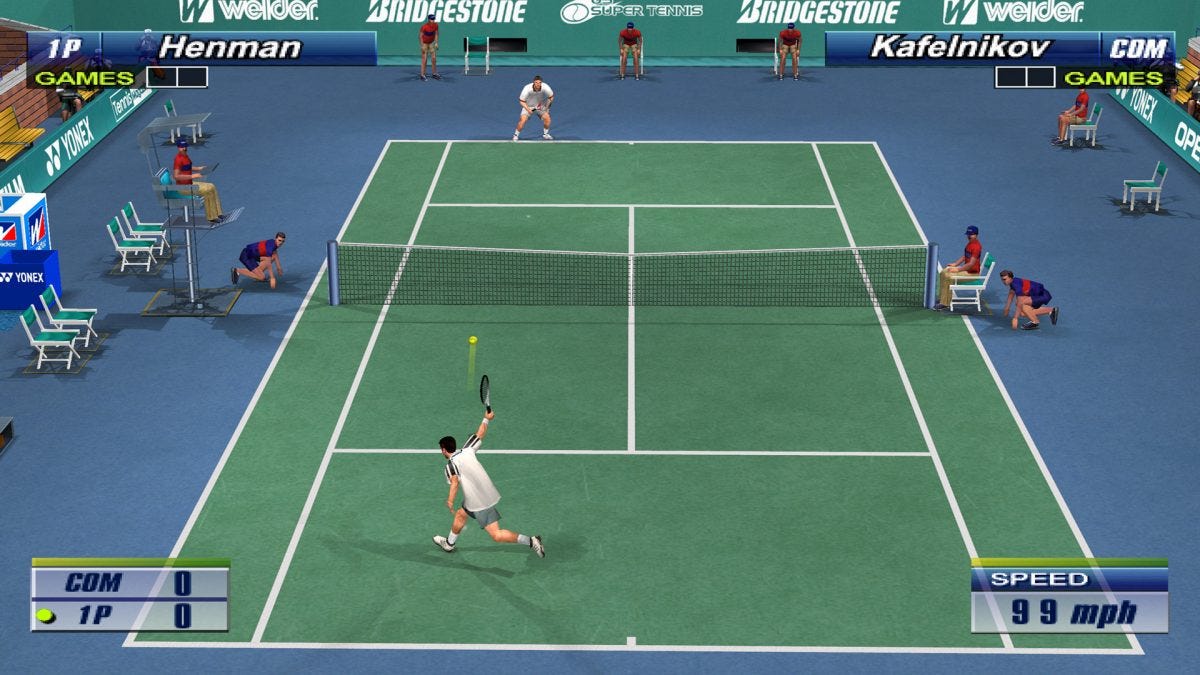Game, Set, Simulation: Virtua Tennis 2 and the Other Wimbledon
Why queue with this tough act to follow
Wimbledon 2025 is done and dusted. The nation, having rediscovered its biannual obsession with tennis (sandwiched neatly between seasonal weather complaints and murmurs about the BBC license fee), now returns to its natural state: queuing for things it doesn’t really want, while pretending to like things it doesn’t really understand. Wimbledon, of course, is the zenith of this ritual — a fortnight-long fever dream where cucumber sandwiches gain mystical properties, and Cliff Richard lurks just offstage like a forgotten Shakespearean subplot, ready to burst into song at the first sign of rain.
The Queue — yes, capital Q — often slithers half a mile or more through the manicured hedgerows of SW19, a line so long and slow it could double as a metaphor for British optimism. Why suffer in heat-waves that would make a Cornish pasty sweat, all for a Centre Court ticket you’re statistically less likely to get than a GP appointment? When instead, for the past twenty years, the purest expression of tennis has been available not on grass, but in your living room — preferably with the curtains drawn and a controller in hand.
Enter Virtua Tennis 2. Released in 2001, it was the Dreamcast's answer to a question no one was asking but everyone was delighted to have answered: “What if tennis, but actually fun?” Before EA’s annual updates turned sports games into digital spreadsheets with advertising, Sega gave us something much rarer — an arcade-perfect simulation of tennis that somehow felt more alive than the sport itself. It was fast, fluid, and unashamedly joyful. Like actual tennis, but with better footwork and no need for isotonic drinks.
Sega’s now-defunct Hitmaker studio was behind it. The name alone sounds like the kind of thing a record producer would call himself in a ‘90s boyband documentary, but in this case it was eerily accurate. These people knew how to make a hit. Not just commercially, but viscerally — games that clicked, popped, and stayed with you like a perfect forehand smash in slow motion. Virtua Tennis 2 took the clean mechanics of its predecessor and layered on career mode, skill training, and a player progression system that — unlike most modern FIFA attempts — didn’t make you feel like you were being punished for trying to enjoy yourself.
The mini-games, in particular, were sublime. Training drills where you smashed serves into bowling pins, or tried to land volleys inside increasingly sadistic targets, felt like the spiritual precursor to every gamified app that would later tell us we were unfit. Only this time, you got better at tennis instead of just feeling bad about your step count.
Then came the roster — a mix of early-2000s legends like Pat Rafter and Tim Henman (yes, we once pinned national hopes on a man who always looked like he’d just apologised for something) alongside future greats like Serena Williams. That’s right: Serena, in 2001. Before she’d won a Grand Slam, before she’d built a dynasty. Virtua Tennis 2 saw it coming. A clairvoyant moment disguised as a character select screen.
And then, of course, there was the gender split. Not a gimmick, not a sidebar — but a full second career path, a radically different play style, and the birth of mixed doubles that actually felt strategic rather than symbolic. Groundstrokes versus serve-and-volley. Patience versus aggression. A sort of playable sociology, disguised as a party game.
And let’s not forget multiplayer — the real kind. Local, face-to-face, sweaty-palm-on-controller multiplayer. Before broadband and headset abuse, back when a trash-talk had to be delivered in person, preferably between mouthfuls of Pringles. You didn’t look like a malfunctioning windmill as you might on Wii Sports, flailing about in front of your nan. You looked cool. Or at least... composed.
Now, I won’t pretend Virtua Tennis 2 offers a digital approximation of strawberries and cream — although one could argue that stuffing your face while waiting your turn to play counts as a sort of cultural homage. And sure, there’s no official Wimbledon branding, no Centre Court or All England Club — just “English Championship” in a font that looks like it escaped from Microsoft Word 97. But by the time you’re breaking a sweat in the semi-final against a feral AI version of Monica Seles, you won’t care. It’s Wimbledon in all but name, and without the rain delays.
You see, while modern sports sims obsess over realism — sweat physics, sponsor logos, interview trees that feel like hostage negotiations — Virtua Tennis 2 reminds us what these games were meant to be: instant, tactile, gleefully addictive. No updates. No microtransactions. No queue. It’s that good. It’s not just a time capsule — it’s a tonic.
And unlike the real thing, it doesn’t need Cliff Richard to save it when the weather turns.








